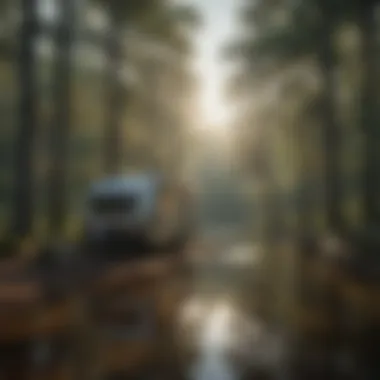Exploring Campgrounds at Lake Sinclair, Georgia


Intro
Exploring the campgrounds at Lake Sinclair, Georgia, reveals much more than just places to pitch a tent. This area is rich in biodiversity and offers a wide range of experiences for nature enthusiasts and families. Understanding the ecosystems surrounding the lake is essential for appreciating this natural habitat. With a focus on sustainable practices, camping trips can contribute positively to the environment. Careful consideration of the facilities and activities available enhances the overall camping experience.
Understanding Woodland Ecosystems
Importance of Biodiversity in Forests
Forests play a critical role in hosting diverse species of plants and animals. Biodiversity is vital for maintaining ecosystem balance, ensuring the health of the environment. In the case of Lake Sinclair, these ecosystems not only support native wildlife but also foster a natural environment enjoyed by visitors. The presence of different species ensures that ecosystems can recover from disturbances, such as storms or human intervention, promoting resilience.
Role of Forests in Climate Regulation
Forests significantly influence local and even global climates. They absorb carbon dioxide and produce oxygen, acting as natural air filters. Forests adjacent to Lake Sinclair contribute to temperature regulation, promoting a microclimate that supports various recreational activities. A healthy forest mitigates the effects of climate change, making it crucial to prioritize the preservation of these areas.
Sustainable Camping Practices
Principles of Sustainable Forestry
Sustainable practices in forestry ensure that ecosystems remain healthy for future generations. These include maintaining biodiversity, reducing waste, and utilizing resources responsibly. Campgrounds around Lake Sinclair often promote sustainable practices, such as using biodegradable soaps and minimizing campfire impact. Visitors should adhere to the principle of leaving no trace, which reinforces the commitment to protecting the environment.
Case Studies of Successful Implementations
Looking at specific campground practices can provide insights into successful sustainability implementations. For example, several campgrounds at Lake Sinclair actively engage in regular assessments to monitor environmental health. Programs for recycling and waste reduction have encouraged guests to participate, improving the overall camping experience while minimizing ecological footprints.
"Maintaining a balance between recreation and conservation is key to the sustainability of our natural stewardship."
Woodland Stewardship Techniques
Forest Management Plans
Effective forest management plans include strategies that resolve potential conflicts between recreation and conservation efforts. These plans often involve setting aside areas for camping while protecting sensitive habitats from human impact. Campgrounds near Lake Sinclair follow strict regulations to ensure that natural resources are not overexploited, benefiting both the environment and visitors.
Conservation Strategies
Implementing robust conservation strategies helps protect the rich ecosystems in the Lake Sinclair area. Community involvement is crucial; therefore, educational programs enhance awareness about local flora and fauna. Regular clean-ups and tree plantings associate community members with the stewardship of the region, creating a strong connection between the public and the natural world.
The integration of these themes underscores the importance of responsible camping in enhancing not just personal experiences, but also communal and ecological well-being. As visitors explore these campgrounds, understanding the underlying principles of ecosystem conservation can lead to mindful engagement with the extraordinary landscape of Lake Sinclair.
Overview of Lake Sinclair
Lake Sinclair is a notable destination in Georgia, attracting visitors with its scenic beauty and recreational opportunities. Understanding its significance enhances the overall experience for camping enthusiasts and families alike, while underpinning the intricate relationship between nature and community life. The lake itself covers over 15,000 acres, offering a diverse range of activities and habitats that appeal to various interests.
Geographical Significance
Lake Sinclair is centrally located in Baldwin County, Georgia, approximately 80 miles southeast of Atlanta. This positioning makes it accessible for both local and out-of-state visitors. The lake is fed by the Oconee River, which plays a crucial role in maintaining water levels and ecological health. Its expansive shoreline includes more than 500 miles of diverse landscapes ranging from wooded banks to sandy beaches. This geographical diversity is a significant aspect as it creates unique habitats for a variety of wildlife.
The interface of water and land forms ideal conditions for both aquatic and terrestrial ecosystems. More importantly, the lake serves as a vital resource for the surrounding communities, providing water for recreational and domestic use. The geographical features not only enhance the aesthetic value of the region but also contribute to its economic vitality through tourism and recreational activities.
Ecological Importance
The ecological significance of Lake Sinclair cannot be understated. This lake supports a rich tapestry of flora and fauna, making it an important habitat for various species. The mixture of habitats—marshlands, forests, and open water—supports populations of fish, birds, and other wildlife. Notably, species like the American bass and bluegill thrive in the lake's waters, making it a focal point for anglers.


Moreover, the lake functions as a natural filtration system. It helps in reducing pollution from surrounding areas, thus maintaining the water quality essential for the local ecosystem. The health of the lake reflects upon the ecological health of the region, making conservation efforts crucial. Local organizations often collaborate on initiatives aimed at preserving the natural habitats around Lake Sinclair, which in turn supports its biological diversity.
Historical Context
The history of Lake Sinclair dates back to its creation in the late 1950s, when the Georgia Power Company dammed the Oconee River. The establishment of the lake transformed the landscape, leading to changes in local communities and economies. Initially, it served as a hydroelectric power source but soon evolved into a popular recreational spot.
Throughout the years, Lake Sinclair has played a significant role in the development of local infrastructure and tourism. The growth of its campgrounds, marinas, and recreational facilities demonstrates the lake's impact on surrounding economies. Historical records show that early settlers recognized the area’s potential for agriculture and commerce, but it is the lake that has cemented its status as a destination for leisure and nature-oriented activities.
In summary, Lake Sinclair’s geographical, ecological, and historical contexts are interconnected. They inform current practices and future initiatives aimed at preserving this valuable resource.
Campground Options Near Lake Sinclair
The availability of campgrounds near Lake Sinclair significantly enhances the appeal of this area for both recreational visitors and local residents. Campgrounds provide essential opportunities for outdoor activities, facilitating a connection with nature. They offer a spectrum of environments, from basic camping setups to more luxurious amenities. Understanding the various campground options around Lake Sinclair enables visitors to make informed decisions based on their unique needs and preferences.
Public Campgrounds
Public campgrounds near Lake Sinclair, managed by local or state authorities, typically offer basic amenities at economical rates. These are ideal for families and nature lovers looking for accessibility without the higher costs associated with private settings. Facilities often include picnic areas, fire pits, restrooms, and, in some cases, swimming access.
Examples of public campgrounds include sites located in the Georgia Power Recreation Area which provide scenic views and proximity to water activities. It's crucial to consider peak times as these campgrounds may fill fast, especially during summer weekends. Reservations are often recommended, particularly for popular areas.
Private Campgrounds
Private campgrounds cater to a diverse audience, often providing enhanced services and personalized experiences. These might include cabins, organized activities, and other amenities like Wi-Fi or laundry services. They tend to focus on family-friendly experiences, making them suitable for groups looking for comfort alongside adventure.
For instance, Lake Sinclair RV Park provides spacious lots for RVs, along with a range of recreational facilities including fishing spots and nature trails. The added comfort can lead to a more pleasurable stay, but it is essential to verify availability and potential fees ahead of time.
RV Parks
For travelers utilizing recreational vehicles, RV parks near Lake Sinclair offer specialized services tailored to this mode of camping. These parks often include full hookups for water, electricity, and sewage, ensuring a convenient experience while enjoying the outdoors. Many RV parks also facilitate community interaction through social events and shared amenities like pools and common areas.
Sinclair Marina and RV Park stands out for its serene location and direct access to boating. This adds an extra layer of convenience for those who wish to explore the lake more extensively. Prior research and reservations are advised, especially during busier months when demand rises.
Choosing the right type of campground is critical. Whether opting for public, private, or RV parks, visitors should assess their priorities, be it cost, amenities, or natural surroundings. Each option near Lake Sinclair presents a unique set of advantages aimed at enhancing the camping experience.
Facilities and Amenities
Facilities and amenities play a significant role in enhancing the experience of campers. They not only provide comfort and convenience but also support a wide range of activities and interactions with the natural environment. At Lake Sinclair, understanding these elements can enrich a visitor's stay and ensure a satisfying camping experience.
Camping Infrastructure
The camping infrastructure at Lake Sinclair is designed to accommodate diverse preferences and needs. Most campgrounds offer options ranging from tent camping to fully equipped cabins. Key components include:
- Tent Pads: Many campgrounds have designated areas for tents, ensuring a flat, stable surface for setup. This is crucial for comfort during the night.
- Cabins: For those seeking a more luxurious experience, rustic cabins provide shelter from the elements while allowing immersion in nature.
- Restrooms and Showers: Clean and accessible restroom facilities are essential for hygiene and comfort. Facilities often include hot showers and flush toilets, enhancing the home-like feel.
- Fire Pits and Grills: Most campgrounds include fire pits or grills, which enable guests to prepare meals and gather around the fire, fostering a sense of community and shared experience.
Accessibility Features
Accessibility is a vital consideration in campground design. Lake Sinclair ensures that significant efforts are made to accommodate visitors with disabilities. Some key features include:
- Accessible Campsites: Designated sites equipped with even ground and enough space for wheelchair access enhance usability.
- Restrooms: Many campgrounds provide ADA-compliant restrooms, ensuring they are spacious and equipped with necessary aids.
- Trails: Some hiking trails are designed to be accessible, allowing those with mobility challenges to enjoy the natural beauty of the lake and surrounding areas without barriers.
Recreational Facilities


Recreational facilities at Lake Sinclair enrich the visitor experience by providing organized activities and equipment. These include:
- Boat Ramps: Easy access to the water encourages boating and fishing.
- Swimming Areas: Designated swimming spots are essential for family-friendly fun during warm weather. Lifeguards may be present depending on the location.
- Playgrounds: Family-oriented campgrounds often incorporate playgrounds, ensuring children have a safe place to play.
- Pavilions: Common areas or pavilions are available for gatherings, communal meals, or groups. They can often be reserved for events and are equipped with seating and tables.
"Understanding the available facilities and amenities at your chosen campground can greatly enhance your experience at Lake Sinclair. Planning ahead allows you to fully enjoy your time in such a beautiful location."
In summary, the facilities and amenities at Lake Sinclair are geared towards making the camping experience as enjoyable and accommodating as possible, meeting the diverse needs of visitors. From thoughtful design in infrastructure to ensuring accessibility, these elements contribute significantly to visitor satisfaction.
Activities at Lake Sinclair Campgrounds
Engaging in recreational activities at Lake Sinclair's campgrounds is vital for maximizing the camping experience. The diverse options available ensure visitors of all ages can enjoy what nature offers. From water activities to trails for hiking, these activities provide significant benefits. They enable individuals to connect with nature, promote physical health, and create lasting memories with family and friends.
Water Sports
Water sports are a key attraction at Lake Sinclair. The lake's expansive surface provides opportunities for various aquatic pursuits. Kayaking and canoeing are popular choices. They allow campers to explore secluded areas and observe wildlife up close. Additionally, jet skiing and tubing provide thrilling experiences for adventure seekers.
Fishing is also a component of water sports. Numerous fishing spots are accessible by boat or from the shore. Anglers can catch species like largemouth bass and crappie, making it an engaging activity for many visitors. Involving families in these activities can also enhance bonding through shared experiences.
Hiking Trails
The hiking trails around Lake Sinclair offer campers a chance to explore the natural beauty of the area. These trails vary in difficulty, catering to both novices and experienced hikers. Walking along these paths promotes physical fitness and allows for moments of tranquility.
Many trails are well-marked, providing essential information about the terrain and wildlife. Scenic viewpoints abound, making hikes rewarding. As hikers move through the landscapes, they may encounter diverse flora and fauna, which can enhance their understanding of local ecology.
Fishing Opportunities
Fishing opportunities at Lake Sinclair are extensive. The lake’s ecosystem supports a variety of fish, making it an ideal destination for both serious anglers and casual ones. Various spots around the shore are suitable for bank fishing, while others allow boat access, widening options for catch.
Many campers find solace in fishing, making it a suitable activity for reflection and relaxation. Local regulations encourage sustainable practices, ensuring the longevity of fish populations. Familiarity with these regulations is essential for all anglers to maintain a healthy ecosystem.
Visitors can also participate in local fishing tournaments organized regularly. These events enhance the community spirit and allow for friendly competition among anglers. Overall, engaging in fishing at Lake Sinclair contributes to the experience within the campgrounds, making it beneficial for everyone.
Sustainable Camping Practices
Sustainable camping practices are essential for preserving the natural beauty of areas like Lake Sinclair. The growing popularity of camping can lead to environmental degradation if not managed correctly. Implementing sustainable practices ensures that campgrounds remain pristine for future generations. It also fosters a deeper connection between campers and the environment, raising awareness about conservation. Here are critical elements involved:
- Minimizing impact: Campers should aim to leave natural areas as they found them, avoiding actions that could harm flora and fauna.
- Resource conservation: Using resources such as water and firewood wisely helps maintain the ecological balance.
- Wildlife protection: Understanding and respecting local wildlife prevents disturbances to their habitats and promotes biodiversity.
Embracing these practices not only enriches the camping experience but also contributes significantly to environmental stewardship.
Leave No Trace Principles
The Leave No Trace principles provide a practical framework for campers to minimize their ecological footprint. These seven principles focus on responsible outdoor ethics. They are:
- Plan ahead and prepare: This ensures a safe trip, reducing the risk of accidents and wrong decisions that could lead to environmental harm.
- Travel and camp on durable surfaces: Campers should stick to established trails and campsites. This practice helps prevent soil erosion and protects vegetation.
- Dispose of waste properly: Campers must pack out what they bring in, including trash and leftover food. Proper disposal also minimizes the risk of attracting wildlife to campsites.
- Leave what you find: Campers should not remove rocks, plants, or historical artifacts. This preserves the natural and cultural environment.
- Minimize campfire impact: Campers should use a camp stove for cooking instead of making fires, and if a fire is necessary, it should be kept small and in designated areas.
- Respect wildlife: Observing wildlife from a distance and not feeding them helps maintain their natural behaviors and habitats.
- Be considerate of other visitors: Keeping noise levels down and maintaining an approachable demeanor promotes a positive atmosphere for all visitors.
Following these principles leads to low-impact camping that prioritizes conservation.
Conservation Efforts
Conservation efforts around Lake Sinclair involve both local initiatives and broader community engagement. Various organizations focus on protecting the area’s natural resources while promoting eco-friendly practices. Some notable efforts include:


- Clean-up campaigns: These events bring together volunteers to remove trash from natural areas, restoring beauty to the landscapes.
- Habitat restoration projects: These initiatives aim to restore native plants and wildlife habitats, enhancing local biodiversity.
- Educational programs: Local groups often provide workshops and resources to educate campers about sustainable practices.
- Policy advocacy: Many organizations lobby for stronger conservation policies to protect Lake Sinclair and surrounding areas.
These efforts emphasize the importance of cooperation between visitors and the community. Engaging in conservation not only benefits the environment but also enriches the camping experience.
Cultural and Environmental Significance
The cultural and environmental significance of Lake Sinclair is multifaceted, reflecting both its historical context and its continuing impact on local communities. Understanding this significance is essential for visitors, campers, and residents alike, as it underpins the relationships people have with the land and its resources. Lake Sinclair is more than just a recreational area; it is a vital space where community and nature intersect, shaping identities and lifestyles.
Cultural Heritage of Lake Sinclair
Lake Sinclair has a rich tapestry of cultural heritage that roots back many generations. The area is recognized not only for its natural beauty but also for its contributions to the local folklore and traditions. Many annual events celebrate the cultural aspects associated with the lake, including fishing festivals and environmental clean-up programs.
Additionally, the lake plays a role in community gatherings. Families often camp here during holidays, where they share stories by the campfire and teach their children outdoor skills. The imprint of this shared experience enhances the cultural narrative of the region, creating a collective memory that connects individuals to their surroundings. This sense of community fosters respect for natural resources, encouraging sustainable practices as an integral part of the local culture.
Impact on Local Communities
The impact of Lake Sinclair on local communities extends beyond recreational activities. Economically, the lake supports businesses that rely on tourism, including local shops, restaurants, and recreational rental services. Thus, it provides employment and sustains livelihoods in the region. The steady influx of visitors helps keep local economies vibrant; for many small towns around the lake, this is crucial for their survival.
Moreover, the lake's presence has led to community initiatives focused on conservation and environmental education. Schools and local organizations often partner to promote awareness about ecosystem protection, emphasizing the lake’s ecological significance. This collaboration has resulted in numerous programs aiming to preserve biodiversity while educating the youth about their environmental responsibilities.
Visitor Information
Understanding visitor information is crucial for a successful experience at Lake Sinclair. This section aims to provide essential details that help potential campers plan their trip effectively. Those who wish to enjoy the great outdoors will benefit from knowing not just when to visit, but also how to prepare for their stay. Proper planning can enhance the trip, ensure safety, and allow for a deeper appreciation of the natural surroundings.
Best Times to Visit
Timing can greatly influence the camping experience at Lake Sinclair. The best times to visit typically align with the seasons that offer the most pleasant weather. Late spring and early fall are usually favored due to warmer temperatures and lesser chances of rain.
- Spring (March - May): This is often the peak season for wildflowers and increased wildlife activity. Temperatures range from mild to warm. The lake becomes vibrant as flora and fauna come alive after winter.
- Summer (June - August): Although popular for water activities, summer can be hot and humid. Visitors should be prepared for potential thunderstorms. However, this season allows for the full range of water sports and family activities.
- Fall (September - November): The autumn months bring cooler air and changing leaves. This period is ideal for those who prefer to hike or fish without the heat. Also, the scenery becomes particularly stunning as the foliage transforms.
- Winter (December - February): Winter offers a different kind of solitude. While it might be cold, the lake is less crowded. This time can be appealing for those who seek quietness and a stark beauty in nature.
Planning Your Trip
Planning your visit to Lake Sinclair involves several considerations that ensure a smooth experience. Here are some important elements to keep in mind:
- Reservations: Many campgrounds at Lake Sinclair require advance reservations, especially during peak seasons. Checking availability online is advisable.
- Packing Essentials: Familiarize yourself with the local weather forecasts before your departure. Carry necessary camping gear including tents, sleeping bags, cooking equipment, and appropriate clothing.
- Transportation: Assess how you will reach Lake Sinclair. Whether driving or using public transportation, ensure you have a clear route and understand the road conditions.
- Safety Measures: Prepare for potential hazards. Familiarize yourself with safety guidelines for camping, including first-aid kits, insect repellents, and understanding wildlife interactions.
- Local Regulations: Research any regulations concerning camping and fishing to avoid potential fines or misunderstandings.
- Food and Supplies: Stock up on food and supplies, especially if there are long distances between stores in the area. Some campgrounds offer limited access to amenities.
Culmination
The conclusion of this exploration serves as a vital component in understanding the multifaceted engagement that campgrounds at Lake Sinclair offer. It wraps up the key insights shared throughout the article, reinforcing essential themes related to camping experiences, amenities, and sustainable practices. By distilling the main points, readers can gain a clearer view of what Lake Sinclair provides for outdoor enthusiasts and families.
Summation of Key Points
One can identify several salient features when considering the campgrounds surrounding Lake Sinclair:
- Diverse Accommodations: The area presents a mix of public and private campgrounds. Each option has unique features suited to various preferences.
- Recreational Opportunities: Activities such as water sports, hiking, and fishing dominate the options for visitors. These activities encourage personal engagement with nature, fostering both relaxation and adventure.
- Sustainability Practices: Emphasis on sustainable camping practices is crucial. By adhering to the Leave No Trace principles, visitors can protect the ecological integrity of Lake Sinclair while enjoying its offerings.
- Cultural Significance: The historical and cultural aspects of Lake Sinclair enhance its allure. Visitors not only enjoy the natural environment but also the rich heritage that the lake and surrounding areas hold.
In highlighting these elements, the summary prepares the reader to appreciate the depth of engagement available at Lake Sinclair.
Encouragement for Sustainable Engagement
Moving forward, participation in sustainable camping practices is not just encouraged; it is essential. The environment surrounding Lake Sinclair is fragile, undergoing pressures from both recreational activities and local communities. Engaging in responsible behaviors ensures that future generations can also experience the lake's beauty.
Key considerations for sustainable engagement include:
- Adhering to Leave No Trace Principles: Visitors should familiarize themselves with these guidelines to minimize their impact on the environment.
- Participating in Local Conservation Efforts: Joining cleanup events or supporting conservation projects can significantly contribute to the preservation of Lake Sinclair.
- Educating Others: Sharing knowledge about sustainability can inspire more visitors to adopt eco-friendly practices.
Ultimately, the lake is not just a destination for leisure but a shared responsibility among all who engage with it. By embracing sustainability, one can amplify the overall value of the experiences at Lake Sinclair.







